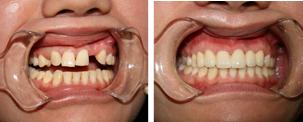What are the types of false teeth?
Many friends have to get dentures due to tooth problems. Nowadays, there are various types of dentures which can be generally divided into two categories: removable dentures and fixed dentures. Which one is more suitable?
According to relevant introductions, fixed dentures include dental implants and porcelain teeth. Porcelain teeth use the good teeth on both sides of the missing tooth gap to fix the denture. Patients cannot remove or wear them by themselves. The manufacturing method of this type of denture is to grind off part of the abutment teeth (teeth used as a base) first, then make a metal crown to cover the abutment teeth, and use another metal rod to connect the two ends with a plastic tooth in the middle.
Dental implants, since the artificial tooth is deeply planted in the jawbone, can withstand normal chewing forces. In terms of function and appearance, it is almost the same as natural teeth, therefore, it is called the third set of human teeth.
The advantages of fixed dentures are small size, comfort, no foreign body sensation, and easy to get used to after being installed in the mouth; its chewing function is greater than that of removable dentures.
The disadvantages of fixed dentures are that the conditions of the abutment teeth at both ends must be good. When preparing, the abutment teeth need to be ground off, which requires higher standards for doctors. Besides, the number of lost teeth should not be excessive, ideally 1-2 missing teeth.
If you want to know the price, it depends on the patient's own situation. You can consult online with a doctor or call the hotline: 4000-454-678.
Removable dentures use plastic as the base, relying on the mucosa and bone tissue for support. It can be freely removed and worn, so it is called a removable prosthesis. It consists of false teeth on the base and elastic metal clasps. The chewing pressure it bears is not entirely dependent on the adjacent teeth on both sides but also partially supported by the gums and alveolar bones in the missing tooth area. Therefore, even if the adjacent teeth on both sides are not very strong, removable dentures can still be installed.
The advantages of removable dentures are relatively simple operation, less grinding of teeth, removable dentures can be taken out for washing, which is beneficial to oral hygiene. "Living teeth" have a wide range of applications and can repair more missing teeth, ranging from one missing tooth to several or even all teeth in the mouth.
The disadvantage of removable dentures is that it takes longer to get used to after installation. It requires a longer period of time to adapt.
In general, dentures must be installed after tooth loss. The main purpose is to restore chewing function and physiological function, avoiding the displacement of other teeth.
Then, which restoration method should be chosen after tooth loss? These two types of dentures each have their pros and cons. The choice is mainly based on the number of missing teeth in the mouth and the health condition of the existing teeth, as well as the patient's needs.
Online URL of this department: http://www.101kq.com/
